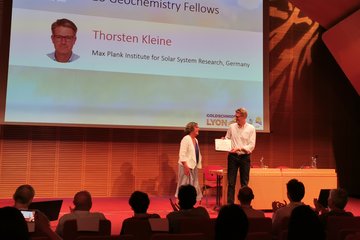Alle Typen
161.
Konferenzbeitrag
Modelling solar and stellar brightness variabilities. In: Coimbra Solar Physics Meeting: Ground-based Solar Observations in the Space Instrumentation Era, Bd. 504, S. 273 - 286. (2016)
162.
Konferenzbeitrag
Magnetic source of the solar cycle variation of the Mn I 539.4 nm line. In: Modern solar facilities-Advanced Solar Science, S. 189 - 192 (Hg. Kneer, F.; Puschmann, K. G.; Wittmann, A. D.). Universitätsverlag Göttingen, Göttingen (2007)
163.
Konferenzbeitrag
Solar Activity and Irradiance Studies with Ca II Spectroheliograms: Potential and Problems. In: The Physics of Chromospheric Plasmas, S. 533 (Hg. Heinzel, P.; Dorotovič, I.; Rutten, R. J.). ASP, San Francisco (2007)
164.
Konferenzbeitrag
Understanding solar variability as groundwork for planet transit detection. In: Stars as Suns: Activity, Evolution, and Planets, S. CD-815-CD-819 (Hg. Dupree, A. K.; Benz, A. O.). Cambridge Univ. Press (2004)
165.
Konferenzbeitrag
Solar total and spectral irradiance: Modelling and a possible impact on climate. In: Proceedings ISCS 2003 Symposium: ``Solar Variability as an Input to the Earth's Environment'', S. 275 - 284 (Hg. Wilson, A.). ESA Publ. Div., Noordwijk (2003)
166.
Konferenzbeitrag
On the origin of solar variability, with an application to the search for extrasolar planets. In: Proc. Workshop ``Toward other Earths: DARWIN/TPF and the Search for Extrasolar Terrestrial Planets'', S. 589 - 593 (Hg. Battrick, B.). ESA Publ. Div., Noordwijk (2003)
167.
Konferenzbeitrag
Cycles and cyclicities of the Sun. In: Proc. Workshop ``Interplay Between Periodic, Cyclic and Stochastic Variability in Selected Areas of the H-R Diagram, S. 423 - 432 (Hg. Sterken, C.). (2003)
168.
Konferenzbeitrag
Solar irradiance fluctuations on short timescales. In: Proceedings ISCS 2003 Symposium: ``Solar Variability as an Input to the Earth's Environment'', S. 285 - 288 (Hg. Wilson, A.). ESA Publ. Div., Noordwijk (2003)
169.
Konferenzbeitrag
Dust in young solar systems. In: Dust in the Solar System and Other Planetary Systems, S. 201 - 216 (Hg. Green; F., S.; others). Elsevier (2002)
170.
Konferenzbeitrag
How large is the Sun's total magnetic flux. In: SOLMAG 2002, Proceedings of the Magnetic Coupling of the Solar Atmosphere, Euroconference and IAU Colloquium 188,, S. 461 - 464 (Hg. Sawaya-Lacoste, H.). ESA Publications Division, Noordwijk (2002)
171.
Konferenzbeitrag
Total solar magnetic flux: dependence on spatial resolution of magnetograms. In: Proc. SOHO-11 Symposium `From Solar Min to Max: Half a Solar Cycle with SOHO', S. 155 - 158 (Hg. Wilson, A.). ESA Publ. Div., Noordwijk (2002)
172.
Vortrag
Cosmic-ray variability on the multi-millennial time scale: A new multi-proxy reconstruction. 36th International Cosmic Ray Conference (ICRC2019), Madison, WI, USA (2019)
173.
Vortrag
Solar brightness variations as they would be observed by the Kepler telescope. Observing the Sun as a star: Would we find the solar system if we saw it?, Göttingen, Germany (2018)
174.
Vortrag
Solar brightness variations as observed by the Kepler telescope. XXXth General Assembly of the International Astronomical Union, Vienna, Austria (2018)
175.
Vortrag
Solar Irradiance Reconstruction over Holocene: A Consistent Multi-proxy Series. The many Sclaes of the Universe: Galaxies, their Suns, and their Planets. Annual Meeting of the German Astronomical Society, Göttingen (2018)
176.
Vortrag
Solar Irradiance Reconstruction over Holocene: A Consistent Multi-proxy Series. Rocks & Stars II Conference, Göttingen (2018)
177.
Vortrag
Solar Irradiance in the Holocene: A Consistent Multi-proxy Reconstruction. 1st Paleoclimate Modelling Intercomparison Project (PMIP4) conference
, Stockholm (2018)
178.
Vortrag
Solar radiative forcing. IAPSO-IAMAS-IAGA Joint Assembly. Good Hope for Earth Sciences - IAPSO-IAMAS-IAGA Joint Assembly 2017, Cape Town, South Africa (2018)
179.
Vortrag
Connecting chromospheric emission to photospheric magnetic field. AG 2017, Göttingen, Germany (2017)
180.
Vortrag
Relating photospheric magnetic field to Ca II K intensity. Rocks \& Stars II, Göttingen, Germany (2017)











